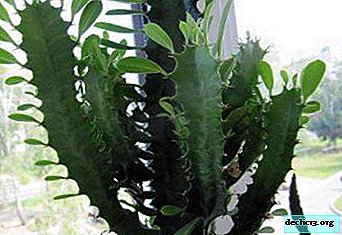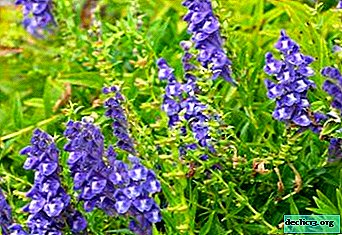Popular types of tropical beauty Hoya: their features and photos
 Wax ivy, porcelain flower - this is also the name of this attractive succulent, firmly established in human life as one of the most unpretentious ornamental plants.
Wax ivy, porcelain flower - this is also the name of this attractive succulent, firmly established in human life as one of the most unpretentious ornamental plants.
This evergreen miracle came to our country from the distant tropics. On the islands of the Pacific Ocean, in Australia and Polynesia, India and Madagascar, on the tops of the Himalayan mountains and southeast Asia, more than 200 species of powerful climbing vineyards with fragrant flowers and small undersized shrubs grow.
Varieties of indoor flower: names with description and photo
Kaudata (Hoya Caudata)
This resident of the tropical forests of Thailand and Malaysia was first described in 1883. The name caudata, which translates as "tailed", was obtained due to the long anther appendages sticking out in the center of the crown.
Dense ovate leaves with a heart-shaped base often have spots of various colors: pink to dark green. With age, the lower part acquires a red tint, and the upper part becomes a frequent silver speck. Long curly stems also change color.
The caudata flowers are white and red, very small and odorless.Bloom for a week. For growing, high humidity, temperature above 20 degrees and bright diffused light are required. To the soil is not demanding.

Variety Caudata silver splash (Caudata silver splash)
This tailed beauty, unlike other representatives of her species, is sensitive to watering. Her the root system rots at the slightest excess of moisture, therefore, drying the soil between irrigations and a good drainage layer are prerequisites.
The plant is not sprayed, but wiped with a damp sponge.In the summer, not only the lower, but also the upper side of its leaves blush. Leafy cuttings are tight to the touch and covered with a thick fluff, which thins with age. It is easy to root, but before the germ appears, you need to wait a few weeks.

David Cummingii
This rare species is named after the Australian collector David Cumming, who was the first to notice and describe the plant in the sparsely populated area of the Philippines. It features unique salmon-pink flowers with a bright yellow center and a delicious caramel smell in the evening. Leaves are lanceolate with barely distinguishable veins. It requires a lot of light and heat, with insufficient water it quickly fades.

Calistophyllus (Callistophylla)
The calistophyll hoya has 18-20 flowers in an umbrella, but this is not what attracts attention, but an unpleasant pungent smell that accompanies flowering. But, despite this, the plant is attractive in appearance: with wide, decorated with dark green veins, leaves and milky yellow flowers on a thin stalk. Artificial lighting in winter is beneficial and accelerates growth.

Imperialis (Imperialis)
One of the largest and most beautiful types of curly hoya. It lives on the peninsula of Malacca. Her flowers, looking like dark red stars with a dazzling white center, begin to exude a strong pleasant aroma at dusk.
It does not tolerate soil moisture and low temperatures.When growing, you need to provide a large amount of light. In winter, you can not do without artificial lighting. Experienced flower growers advise rinsing imperialis once a month under a warm shower and replanting the plant in the soil with the addition of lime. The first flowers appear in the second year after rooting. For heavy stalks, a support in the form of a lattice or arc is mastered.

Loki (Lockii)
In nature, grows at an altitude of 20-25 meters above the ground, in open sunny places. This is the endemic of Vietnam: the only colony growing in the wild, consists of 50 plants and is carefully protected from destruction. With good home care, she is able to please white flowers with a pearl-pearl shade all year long. The smell of flowers is similar to the smell of chocolate, intensifies by night.

Shepherdii (Shepherdii)
Homeland Shepherd - Himalayan heights. It blooms profusely in the light and in the shade.. The corolla of the flower is pubescent, the petals are pale pink, the crown is purple. The leaves are very narrow and long, in the form of a boat with a bright green vein in the middle. On hot summer days, shading from direct sunlight is necessary. For the winter period, the room temperature drops to 16 degrees, watering is reduced to 1 time per week.

Balance (Balaensis)
Curly epiphyte with broadly oval leathery leaves and thin reddish-brown lashes. A flower umbrella can contain up to 50 flowers. The corollas are creamy white, with a velvety inner surface of the petals and a sugary sweetish aroma. Under intense light, pink or silver blotches appear on the leaves. It requires daily spraying with warm water.

Laziantha (Lasiantha)
Grows in shaded places by a bushhas pointed leaves with gray marks and a pubescent corolla. The flowers are bright yellow with a tart, faint aroma of tropical fruits. Any newcomer will cope with the cultivation of this species. If you maintain a constant friability and moisture in the soil, the lasiant can bloom all year round.

Undulata
In the hollow internodes of this plant, ants, ticks, wasps and other arthropods equip their homes. Wavy leaves of dark green color with violet and gray spots interspersed in the form of clusters. Under bright light, they turn purple.
Since this hoya is accustomed to the damp, moist forest, special conditions must be created for cultivation. Rooted by freshly cut cuttings. Flowering period 2-3 days, the buds are creamy pink inside with purple-red dots.

Archiboldiana (Archboldiana)
First exported from the islands of New Guinea in 1933. The most heat-loving hoya, prefers temperatures above 30 degrees and plentiful frequent watering. It blooms 2-3 years after rooting. There are three options for the color of the buds: lilac, pink and red. Propagated by cuttings in a waterproof substrate or water.

Byakensis (Biakensis)
The leaves are oblong with a bright vein; in the summer months a red border appears on them. The flowers are odorless; on the peduncle, their number does not exceed 30 pieces. Petals are pale yellow, oily, translucent. With good care, flowering can be expected at any time of the year.
It gives out milky-colored sweet juice.It is grown both ampelously and on a support on the southern windowsill. Tolerant to temperature extremes, loves bright light, so backlighting is necessary in autumn and winter. The soil must always be moist.and watering and spraying - daily and plentiful.

Globulosa (Globulosa)
In nature, grows in the wild forests of India and China. Large-leaf curly hoya growing only on a support. Umbrellas are large, spherical, with pale yellow flowers. The stem is covered with thin hairs, which fall with age, and the stem itself is lignified. It is grown in cool and at high humidity and air.

Sunrise
As a result of crossing two samples: lacunosa and obscura, this quickly flowering and unpretentious plant appeared, with smooth narrow leaves and fragrant flowers. For the ability to change the saturation of the petals (from pale pink to bright pink), depending on the intensity of the light, this name was translated as "sun rise".

Tsangii
It is distinguished by succulent, rhomboid, elliptic leaves and a leaf plate bent in the opposite direction. Flowers of a honey shade with madder middle, strongly smell of honey. Grown in a cool room in the shade.

Pachyclada (Pachyclada)
It has juicy, durable whips and round dense small leaflets, slightly pubescent with hairs. The corolla of the flower is velvety, the lobes are turned back, beige. The crown is milky or snow-white, with raspberry and pinkish spots.
In the spring bloom spreads the aroma of burnt caramel, attracting ants. The soil for breeding must be stocked with aluminum and nitrogen, with a low content of alkali and silica. Watering is weak tolerates midday heat and prolonged drought.

Serpens
Creeping dense stems are similar to snakes crawling along branches, over time covering trees with a dense continuous carpet. Dense hairs growing on the leaves create an iridescent effect. The flowers are white, with a greenish tint, very fragrant and almost always larger than the leaves, but rarely bloom in a domestic plant.
It does not tolerate stuffiness and dry air.It is best grown in a cool room or terrarium, in a flat container with breathable soil, and often sprayed.

Campanulata
The originality of this hoya is in bell flowers with a pronounced lemon smell. Colors - white, milky, yellow in all shades. Inflorescences are like open parachutes and gathered in thick umbrellas. The height of the bush is 60-70 centimeters.
This whimsical guest of the rainforest requires special care. Basically, it consists in maintaining a temperature of 20-25 degrees and shading. The pot should be small, with a step ladder on which the hoya will rely on when growing.

Willosa (Villosa)
It grows in the territory of Cambodia, Siam and Laos. The leaves are rectangular-elliptical, wavy along the edge, 8-11 long and 3-4 centimeters wide, with convex veins. This species has the most fluffy leaves of all existing. The stalk is thin, lignified with age. Propagated by cuttings in water using a root stimulant. Watering is neat, moderate, until the earth coma is completely dry.

Kalimantan
The growth form is a liana. Leaves are medium sized, oval, pointed. On the surface there is a contrasting pattern of veins of dark blue color. The flowers are ruby in color with yellow stripes, the aroma is similar to the aroma of bergamot. Most willingly grows in a cramped pot with enough light. He likes thorough drying of the substrate and fertilizing with phosphorus.

Monette (Monettea)
In this curly epiphyte, the milky juice has a viscous and transparent consistency, unlike the juice of the other hoy. The lashes are fleshy and strong. The leaves are oval, 15 centimeters wide and 20 centimeters long, with a sharp tip and a smooth base, gray-green, thick and velvety pubescent, with pubescence more pronounced on the lower side than on the upper.
Flat white flowers are odorless, open in a hemispherical large umbrella, flowering time - 10-15 days. Low percentage of captivity in captivity.

Fitchi (Fitchii)
With remarkable emerald green, medium sized leaves. They are smooth, glossy, without pubescence. The color of the flowers is variable and depends on the light intensity. It ranges from pale cream with pinkish tones to bright pink. The umbrella reveals 15 - 25 "wax" flowers.
The petals of the crown are bent back. The inner crown is pink with a darker convex center. This species requires a moist and warm content. Lowering the temperature below 18 degrees threaten the death of the plant.
Watering should be plentiful, but water stagnation in the ground should not be allowed. It is advisable to bathe the plant more often under a warm shower.When using artificial lighting on the glossy surface of the leaves, a beautiful grid of dark blue veins is clearly drawn. This specimen is the slowest growing species of hoya..

Buotii (Buotii)
Distribution area - Philippines. The first description refers to 2002. A plant with a thin, curly stem covered with hard dark warts. Flower petals have a smooth middle and furry pubescence along the edges, the buds themselves are painted in a pale yellow color with a scarlet inner crown. Their delicate delicate aroma resembles the smell of vanilla. Flowering lasts 10-12 days.
Leaf length - 10 cm, width - 4. They have a succulent structure, with a pronounced vein in the center and sharp tips, thin, elliptical in shape. Hoya buoti is unpretentious and quickly takes root. He loves warmth and feels good in the sun. In winter, it requires artificial lighting with fluorescent lamps for 14-16 hours. Not afraid of high humidity. Reproduction is carried out by cuttings in sphagnum or water.

Conclusion
Plants not only decorate the home and create comfort in it. It is believed that each of them carries energy that can have an impact on human life. It is the hoya that is called the plant for the family, which helps to establish harmony and bring peace to the fate of its owner. Add one more to your home garden and check - do ancient signs really work?

















